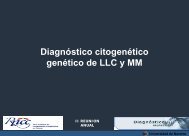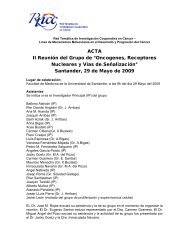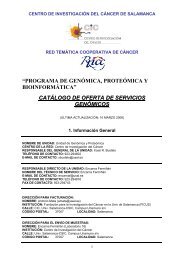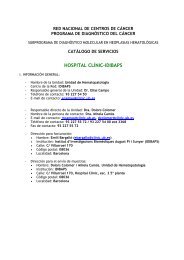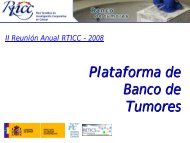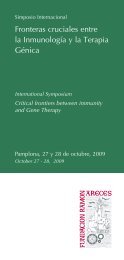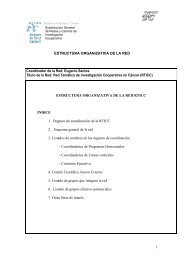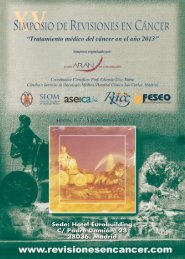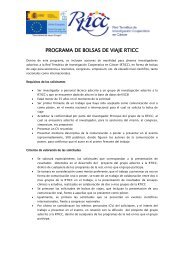Untitled - Red Temática de investigación cooperativa en cáncer
Untitled - Red Temática de investigación cooperativa en cáncer
Untitled - Red Temática de investigación cooperativa en cáncer
Create successful ePaper yourself
Turn your PDF publications into a flip-book with our unique Google optimized e-Paper software.
P-07<br />
DIOXIN RECEPTOR KNOCK-DOWN PROMOTES PRIMARY AND TGF-INDU-<br />
CED EPITHELIAL-MESENCHYMAL TRANSITION<br />
RICO-LEO EM 1 , ALVÁREZ-BARRIENTOS A 1 , FERNÁNDEZ-SALGUERO PM 1<br />
1<br />
UNIVERSIDAD DE EXTREMADURA, BADAJOZ (R006/0020/1016)<br />
Rec<strong>en</strong>t studies have highlighted the role of the dioxin receptor (AhR) in maintaining cell<br />
morphology, adhesion and migration. Overall, those AhR functions <strong>de</strong>p<strong>en</strong>d on the cell ph<strong>en</strong>otype<br />
and while AhR expression maintains mes<strong>en</strong>chymal fibroblasts migration it also inhibits<br />
keratinocytes motility.<br />
These observations prompted us to investigate whether AhR modulates the epithelial-tomes<strong>en</strong>chymal<br />
transition (EMT) in primary AhR + / + and AhR-/- keratinocytes and in NMuMG<br />
cells <strong>en</strong>gineered to knock-down AhR (sh-AhR) or to express a constitutively active receptor<br />
(CA-AhR). Both AhR-/- keratinocytes and sh-AhR NMuMG cells had increased migration and<br />
reduced levels of epithelial markers E-cadherin, -cat<strong>en</strong>in together with increased amounts<br />
of mes<strong>en</strong>chymal markers Slug/Snai2, Snail, vim<strong>en</strong>tin, N-cadherin and -smooth muscle actin.<br />
Consist<strong>en</strong>tly, CA-AhR NMuMG cells had reduced migration and more pronounced expression<br />
of epithelial markers. TGF exacerbated the pro-migratory mes<strong>en</strong>chymal ph<strong>en</strong>otype in<br />
both AhR-expressing and AhR-<strong>de</strong>pleted cells, although the effects on the latter were more<br />
significant.<br />
Rescuing AhR expression in sh-AhR cells reduced migration and Slug/Snai2 and Snail expression<br />
and restored E-cadherin levels. Human HaCaT cells, interfered for AhR (si-AhR),<br />
further supported the AhR-<strong>de</strong>fici<strong>en</strong>t EMT ph<strong>en</strong>otype.<br />
Interestingly, co-immunoprecipitation and immunofluoresc<strong>en</strong>ce assays showed that AhR<br />
associates with E-cadherin and -cat<strong>en</strong>in in common protein complexes, arguing for the<br />
exist<strong>en</strong>ce of non-nuclear roles of AhR in cell migration. Thus, reducing AhR expression in<br />
epithelial cells favors EMT, a ph<strong>en</strong>otypical change pot<strong>en</strong>tially relevant in normal <strong>de</strong>velopm<strong>en</strong>t<br />
and in such diseases as metastatic cancer.<br />
P-08<br />
ANÁLISIS DE LAS ALTERACIONES CITOGENÉTICAS EN 2131 PACIENTES<br />
CON LLC Y LBM. ESTUDIO MULTICÉNTRICO DEL GCECGH Y GELLC<br />
PUIGGROS A 1 , COLLADO R 2 , DELGADO J 3 , HERNÁNDEZ JA 4 , HERNÁNDEZ JM 5 , SOLÉ F 1 , CARBO-<br />
NELL F 2 , ESPINET B 1<br />
1<br />
HOSPITAL DEL MAR, PARC DE SALUT MAR BARCELONA (RD07/0020/2004)<br />
2<br />
HOSPITAL GENERAL UNIVERSITARIO DE VALENCIA, VALENCIA<br />
3<br />
HOSPITAL CLÍNIC, BARCELONA<br />
4<br />
HOSPITAL UNIVERSITARIO INFANTA LEONOR<br />
5<br />
HOSPITAL UNIVERSITARIO DE SALAMANCA, SALAMANCA (RD06/0020/0006)<br />
Introducción: Las alteraciones citog<strong>en</strong>éticas ti<strong>en</strong><strong>en</strong> valor pronóstico <strong>en</strong> la leucemia linfática<br />
crónica (LLC), si<strong>en</strong>do las más frecu<strong>en</strong>tes: <strong>de</strong>l(13q), +12, <strong>de</strong>l(11q) y <strong>de</strong>l(17p). Exist<strong>en</strong><br />
pocas series amplias <strong>de</strong> citog<strong>en</strong>ética conv<strong>en</strong>cional (CC) <strong>en</strong> LLC. Respecto a la linfocitosis B<br />
monoclonal (LBM), los estudios por FISH sugier<strong>en</strong> alteraciones similares a la LLC.<br />
Objetivos: Valorar la inci<strong>de</strong>ncia <strong>de</strong> alteraciones recurr<strong>en</strong>tes por CC y/o FISH, e integrarla<br />
con datos clínico-biológicos. Desarrollar estudios <strong>de</strong>rivados que analic<strong>en</strong> específicam<strong>en</strong>te<br />
alteraciones concretas.<br />
Paci<strong>en</strong>tes y Métodos: En el marco <strong>de</strong>l Grupo Cooperativo Español <strong>de</strong> Citog<strong>en</strong>ética Hematológica<br />
y <strong>de</strong>l Grupo Español <strong>de</strong> LLC, se han recogido los datos clínico-biológicos <strong>de</strong> 2131<br />
paci<strong>en</strong>tes con LLC/LBM. 898 pres<strong>en</strong>taban datos <strong>de</strong> CC, 1835 datos <strong>de</strong> FISH (13q14, 12,<br />
11q22.3 y 17p13) y 698 información <strong>de</strong> ambas al diagnóstico.<br />
Resultados: Se han estudiado 1738 LLC y 393 LBM. Las principales características clínicobiológicas<br />
y <strong>de</strong> seguimi<strong>en</strong>to se recog<strong>en</strong> <strong>en</strong> la Tabla. Un 81,4% <strong>de</strong> LLC se diagnosticaron<br />
<strong>en</strong> estadío A <strong>de</strong> Binet y un 38,8% progresaron. Un 23,4% <strong>de</strong> LBM progresaron a LLC.<br />
La frecu<strong>en</strong>cia <strong>de</strong> cariotipos alterados no difería significativam<strong>en</strong>te <strong>en</strong>tre LLC y LBM (36%<br />
vs 34%). Las anomalías más frecu<strong>en</strong>tes <strong>de</strong>tectadas <strong>en</strong> LLC por CC eran: +12, alt. 13q,<br />
<strong>de</strong>l(11q), t(18q21), t(14q32), <strong>de</strong>l(6q) y +18, +19. Por FISH, ambas <strong>en</strong>tida<strong>de</strong>s pres<strong>en</strong>taron<br />
porc<strong>en</strong>tajes similares <strong>de</strong> +12 y <strong>de</strong>l(13q). La <strong>de</strong>tección <strong>de</strong> <strong>de</strong>l(11q) y <strong>de</strong>l(17p) fue significativam<strong>en</strong>te<br />
inferior <strong>en</strong> la LBM.<br />
Conclusiones: 1.La frecu<strong>en</strong>cia y tipo <strong>de</strong> alteraciones por CC <strong>de</strong> la serie española son<br />
similares a los <strong>de</strong>scritos <strong>en</strong> otras series <strong>de</strong> LLC. 2.El porc<strong>en</strong>taje <strong>de</strong> <strong>de</strong>tección <strong>de</strong> anomalías<br />
por FISH es ligeram<strong>en</strong>te inferior al <strong>de</strong>scrito por Döhner y cols (2000), especialm<strong>en</strong>te<br />
<strong>de</strong> <strong>de</strong>l(11q) (9% vs 18%). 3.La inci<strong>de</strong>ncia <strong>de</strong> alteraciones <strong>en</strong> LBM es similar a la <strong>de</strong> LLC,<br />
aunque las alteraciones <strong>de</strong> 11q y 17p, <strong>de</strong> mal pronóstico, son m<strong>en</strong>os frecu<strong>en</strong>tes. 4. La ampliación<br />
<strong>de</strong> esta serie permitirá realizar estudios, algunos <strong>de</strong> los cuales ya están <strong>en</strong> marcha,<br />
que analic<strong>en</strong> el impacto <strong>de</strong> alteraciones citog<strong>en</strong>éticas específicas con un tamaño muestral<br />
a<strong>de</strong>cuado.<br />
50 51



